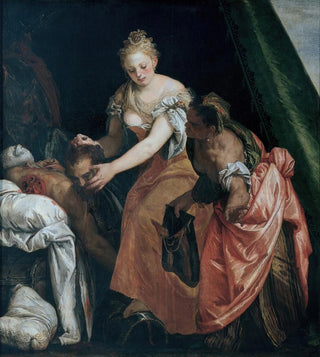Art print | Judith and Holofernes - Paolo Véronèse


View from behind

Frame (optional)
"Judith and Holofernes" art print by Paolo Véronèse is a painting that transcends the simple frame of traditional painting to offer a true aesthetic and narrative experience. This dramatic representation, inspired by the biblical story, immerses the viewer in a universe where beauty and violence coexist. Through a play of light and vibrant colors, Véronèse manages to capture the intensity of a crucial moment, where Judith, armed with courage and determination, prepares to deliver her people from oppression. The emotionally charged scene invites deep reflection on power, femininity, and the fight for freedom.
Style and uniqueness of the artwork
Véronèse's technical mastery is evident in every detail of this iconic piece. His bold use of vivid colors and striking contrasts creates an atmosphere that is both dramatic and captivating. The sumptuous drapery of Judith's and Holofernes' garments reveals a keen sense of movement and texture, while the expressions of the characters, both powerful and vulnerable, add a psychological dimension to the scene. The choice of theatrical lighting accentuates each face's features, making palpable the tension emanating from this confrontation. Véronèse thus succeeds in making this painting a work where every element is carefully orchestrated to serve the story, transforming a moment of violence into a celebration of bravery and beauty.
The artist and his influence
Paolo Véronèse, an emblematic figure of the Italian Renaissance, established himself through his unique style and his ability to fuse the grandeur of religious themes with refined aesthetics. Active in Venice in the 16th century, the artist was influenced by his contemporaries while developing a distinctive signature characterized by dynamic compositions and vibrant colors. His work "Judith and Holofernes" perfectly illustrates this duality, blending sacred history with an almost theatrical approach. Véronèse not only marked his era but his influence endures through the centuries, inspiring many artists who see in him a model of creativity and innovation. His legacy is reflected in the way

Matte finish

View from behind

Frame (optional)
"Judith and Holofernes" art print by Paolo Véronèse is a painting that transcends the simple frame of traditional painting to offer a true aesthetic and narrative experience. This dramatic representation, inspired by the biblical story, immerses the viewer in a universe where beauty and violence coexist. Through a play of light and vibrant colors, Véronèse manages to capture the intensity of a crucial moment, where Judith, armed with courage and determination, prepares to deliver her people from oppression. The emotionally charged scene invites deep reflection on power, femininity, and the fight for freedom.
Style and uniqueness of the artwork
Véronèse's technical mastery is evident in every detail of this iconic piece. His bold use of vivid colors and striking contrasts creates an atmosphere that is both dramatic and captivating. The sumptuous drapery of Judith's and Holofernes' garments reveals a keen sense of movement and texture, while the expressions of the characters, both powerful and vulnerable, add a psychological dimension to the scene. The choice of theatrical lighting accentuates each face's features, making palpable the tension emanating from this confrontation. Véronèse thus succeeds in making this painting a work where every element is carefully orchestrated to serve the story, transforming a moment of violence into a celebration of bravery and beauty.
The artist and his influence
Paolo Véronèse, an emblematic figure of the Italian Renaissance, established himself through his unique style and his ability to fuse the grandeur of religious themes with refined aesthetics. Active in Venice in the 16th century, the artist was influenced by his contemporaries while developing a distinctive signature characterized by dynamic compositions and vibrant colors. His work "Judith and Holofernes" perfectly illustrates this duality, blending sacred history with an almost theatrical approach. Véronèse not only marked his era but his influence endures through the centuries, inspiring many artists who see in him a model of creativity and innovation. His legacy is reflected in the way






